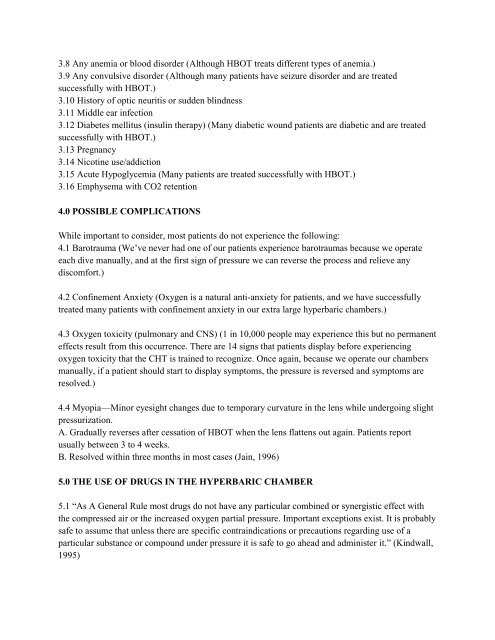HYPERBARIC OXYGEN THERAPY INDICATIONS ...
HYPERBARIC OXYGEN THERAPY INDICATIONS ...
HYPERBARIC OXYGEN THERAPY INDICATIONS ...
You also want an ePaper? Increase the reach of your titles
YUMPU automatically turns print PDFs into web optimized ePapers that Google loves.
3.8 Any anemia or blood disorder (Although HBOT treats different types of anemia.)<br />
3.9 Any convulsive disorder (Although many patients have seizure disorder and are treated<br />
successfully with HBOT.)<br />
3.10 History of optic neuritis or sudden blindness<br />
3.11 Middle ear infection<br />
3.12 Diabetes mellitus (insulin therapy) (Many diabetic wound patients are diabetic and are treated<br />
successfully with HBOT.)<br />
3.13 Pregnancy<br />
3.14 Nicotine use/addiction<br />
3.15 Acute Hypoglycemia (Many patients are treated successfully with HBOT.)<br />
3.16 Emphysema with CO2 retention<br />
4.0 POSSIBLE COMPLICATIONS<br />
While important to consider, most patients do not experience the following:<br />
4.1 Barotrauma (We’ve never had one of our patients experience barotraumas because we operate<br />
each dive manually, and at the first sign of pressure we can reverse the process and relieve any<br />
discomfort.)<br />
4.2 Confinement Anxiety (Oxygen is a natural anti-anxiety for patients, and we have successfully<br />
treated many patients with confinement anxiety in our extra large hyperbaric chambers.)<br />
4.3 Oxygen toxicity (pulmonary and CNS) (1 in 10,000 people may experience this but no permanent<br />
effects result from this occurrence. There are 14 signs that patients display before experiencing<br />
oxygen toxicity that the CHT is trained to recognize. Once again, because we operate our chambers<br />
manually, if a patient should start to display symptoms, the pressure is reversed and symptoms are<br />
resolved.)<br />
4.4 Myopia—Minor eyesight changes due to temporary curvature in the lens while undergoing slight<br />
pressurization.<br />
A. Gradually reverses after cessation of HBOT when the lens flattens out again. Patients report<br />
usually between 3 to 4 weeks.<br />
B. Resolved within three months in most cases (Jain, 1996)<br />
5.0 THE USE OF DRUGS IN THE <strong>HYPERBARIC</strong> CHAMBER<br />
5.1 “As A General Rule most drugs do not have any particular combined or synergistic effect with<br />
the compressed air or the increased oxygen partial pressure. Important exceptions exist. It is probably<br />
safe to assume that unless there are specific contraindications or precautions regarding use of a<br />
particular substance or compound under pressure it is safe to go ahead and administer it.” (Kindwall,<br />
1995)


